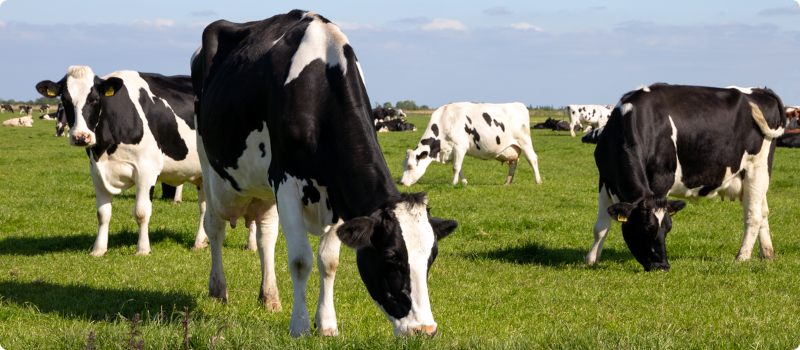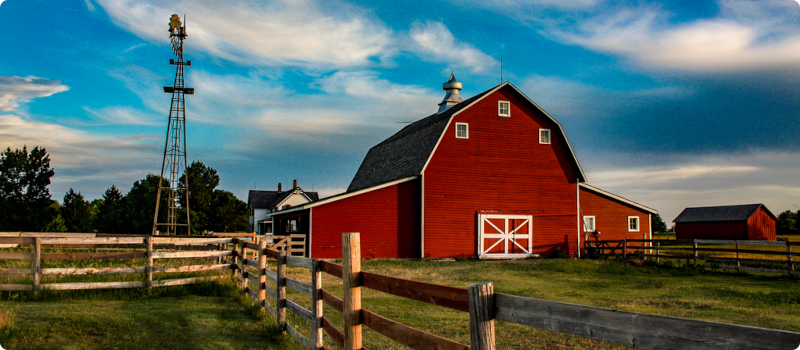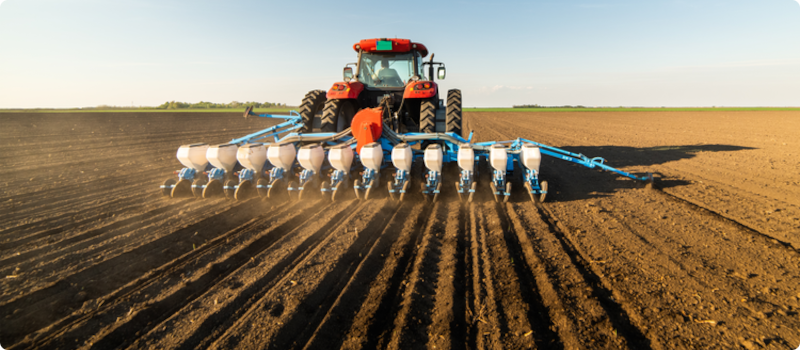What does farm personal property insurance cover?
Updated June 27, 2024 . AmFam Team
Are you looking to protect your farm but not sure where to start? Adding farm personal property insurance could be the solution you’re looking for. You can customize your coverage to fit your unique farming situations.
Farm personal property insurance typically covers items used in your farming operations. These items usually fall into one of three categories: farm machinery or equipment, livestock and farm supplies. Let’s look at each of these categories in a little more detail to see how they come into play and where your property fits in.
Farm machinery and equipment. As you may assume, this coverage is for your essential farm equipment and machinery such as your tractors, combines, cotton pickers and other equipment that keep your farm running smoothly and efficiently. But it also offers coverage to items you might not initially consider — like your computers, other office equipment, tools and supplies. It can also cover your portable items like irrigation systems.
Livestock. Your livestock is important to your operation and requires extra attention and protection. If you lose livestock due to a covered event, this insurance helps with the costs of replacing this valuable aspect of your farm or ranch.
Feed, grain, tools, supplies. The farm products category covers a broad base of items including grain, silage, pesticides, fertilizers and more. You’ll want to discuss this thoroughly with your American Family Insurance agent to determine what products you want covered and if there are any special requirements, such as method of storage.

When does farm personal property insurance kick In?
The goal of farm personal property insurance is to give you added protection in the event of certain situations or events. Reducing risks is your primary line of defense against loss, but sometimes the events are out of your control. With farm personal property coverage, you are prepared for those unexpected events.
When Mother Nature comes calling. Weather plays a big role in the day-to-day operations of your farm. Sometimes it’s a blessing, sometimes Mother Nature has other things in mind. This coverage gives you added protection if you suffer losses from lightning, windstorms and hail. It also provides coverage if there is a sinkhole collapse or volcanic action.
Fire, smoke and explosions. Fire poses an obvious threat to your farm and you want to do all you can to protect your operation. While you’re thinking of fire, don’t let the possibility of smoke damage go overlooked. This coverage gives you protection in the event of both or either situation. It also protects you if an explosion damages your property.
Vehicles, aircraft and collisions. Vehicles can cause damage to your property, whether they’re your farm vehicles or passenger vehicles that belong to others. With this coverage you get help recovering any losses if a car of a plane hits your property. You’re also covered if your farming equipment causes damage, like your combine hits a post.
Criminal acts of others. If your farm experiences loss or damage from theft, vandalism, riot or civil commotion, this insurance is your go-to for coverage of your farm personal property.
Loss to livestock. Your livestock is important to your operation, and protection from loss is a smart way to add security to your investment. This coverage includes earthquake loss, theft, vandalism, lightning, fire and electrocution.

Blanket or scheduled coverage for your personal property
If you’re considering farm personal property insurance, there are two different types of coverage, blanket or scheduled. You can select the one that you feel fits your personal property needs best.
Blanket coverage. With this option, you select a blanket coverage limit, you can then fluctuate your farm personal property coverage, across your operation, up to that limit. This gives you the flexibility to protect what matters most to you and your farm. Blanket coverage can provide protection on one property category or on several types of property grouped together under one blanket limit.
Scheduled coverage. This coverage lets you pick individual items that you want to insure and allows you to assign a specific amount of insurance to each item. This is a great way to customize your coverage based on your specific needs, usage and budget. It also gives you adequate limits for higher valued items. This is ideal for new tractors, combines and other large pieces of equipment.
One thing to note, if you have a lien on any property, your lender may require scheduled coverage for that particular item. In this situation, you may want to discuss special coverage, such as replacement cost, with your American Family Insurance agent so you’re confident you’re getting the right protection for your situation.

Additional coverages for farm personal property
If you’d like to take customizing your farm personal property coverage a step further, there are extra protection options that give you added confidence when it comes to the following property and situations.
GPS units. Your GPS guidance systems are an essential part of your business. And with this added endorsement you get more coverage for this vital technology.
Peak season endorsement (including livestock). This endorsement can be used for livestock, grain, feed, hay, silage, fertilizer and more. It gives you coverage for peak values of inventory for a specified period of time.
Replacement cost of irrigation systems. Keeping your irrigation system in working order is critical for producing successful crops. With this endorsement, depreciation of your irrigation system is not applied and we’ll work to replace it to keep your operation running smoothly.
Replacement cost for machinery and equipment. You rely on your machinery and equipment on a daily basis and a breakdown could cause significant problems. This endorsement is designed for machinery and equipment that is 10 years of age or newer. It should be insured for full replacement cost value as co-insurance does apply.
Farm income. This endorsement is designed to pay for continuing expenses if there is a covered loss. One example would be a fire to your hog confinement. You discover that it will take four months for the building to be repaired and you to begin operations again. During the four months, you still need to pay your bills, wages, loans, etc. With the farm income endorsement you can move ahead, without those bills weighing on your mind.
Suffocation of livestock – property owned and non-owned. This covers any livestock you are responsible for, whether you own it or not.
Care, custody and control property. This endorsement gives you livestock coverage for animals you care for. For example, this coverage is used if you rent your building to a neighbor to board their horses and you agree to care for the animals. With this protection, your neighbor’s animals have insurance protection in the event of a covered incident. Connect with your agent to learn more about this endorsement and to evaluate your needs based on your rental situation.
Milk contamination. If contamination happens to the milk of others, your liability insurance will cover it. But if the milk you produce is contaminated by a covered loss you will be protected by this endorsement. You have the option of selecting either a 10% or a 20% deductible option.

Equipment rented or borrowed from others. If you are renting or borrowing equipment, this endorsement protects you from having to cover any damage that occurs. There are some choices on how much coverage you can get, so it’s a great idea to talk over your concerns with an agent and evaluate the options available.
Re-bagging and re-covering expenses. If the covering that protects your feed is damaged from a covered peril such as fire, wind, hail, lightning, machinery contact, etc. then this endorsement provides for the expenses associated with re-bagging or re-covering the contents.
Farm machinery and equipment — open perils. Add additional peril coverage to your machinery, equipment and for things like rock ingestion, rodent damage to wiring and more with this endorsement.
Ingestion of foreign objects for farm machinery and equipment coverage. Ingestion of a foreign object into your machinery or equipment can cause a lot of damage. This coverage protects you in that situation. You can add this endorsement to either a schedule or blanket farm personal property insurance plan to give you additional coverage from $5,000 to $100,000.
Property in transit. Moving property adds some risks you don’t normally face, so it makes sense to protect your farm personal property if you’re going to be moving it from place to place.
Added animal perils. This endorsement is used to help you recover from a loss of livestock caused by accidental shooting, drowning, attack by dogs or wild animals or collapse of a building.
Winter perils. If your farm is blanketed in a layer of snow every winter, then you may want to consider adding the winter perils endorsement to your policy. This optional endorsement provides coverage for loss resulting from death caused or made necessary by freezing or smothering in a snowstorm or ice storm or from falling through the ice.
If you want to be proactive about your farm or ranch, connect with your American Family Insurance agent, they’ll help you make sure you select the right coverage for your property. You’ve worked hard to create an operation that you’re proud of and it means everything to you. Farm personal property insurance is just another way to protect what matters most to you.
This information represents only a brief description of coverages, is not part of your policy, and is not a promise or guarantee of coverage. If there is any conflict between this information and your policy, the provisions of the policy will prevail. Insurance policy terms and conditions may apply. Exclusions may apply to policies, endorsements, or riders. Coverage may vary by state and may be subject to change. Some products are not available in every state. Please read your policy and contact your agent for assistance.

